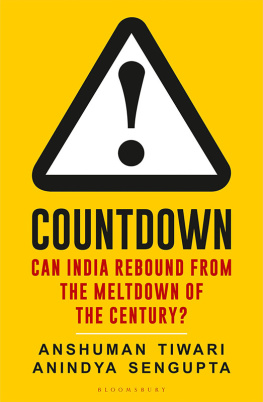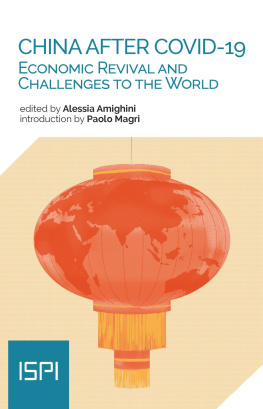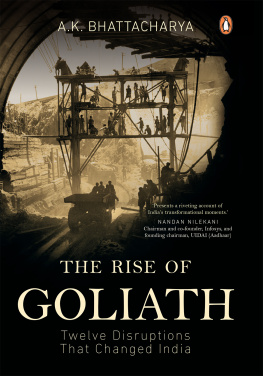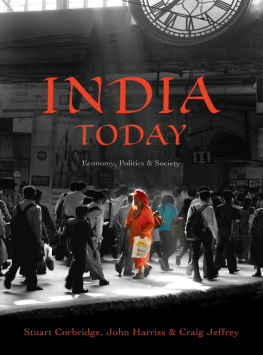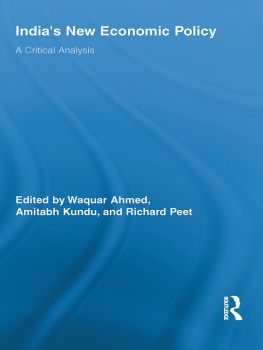Table of Contents

COUNTDOWN
COUNTDOWN
Can India Rebound from the Meltdown of the Century?
Anshuman Tiwari
Anindya Sengupta

BLOOMSBURY INDIA
Bloomsbury Publishing India Pvt. Ltd
Second Floor, LSC Building No. 4, DDA Complex, Pocket C 6 & 7,
Vasant Kunj, New Delhi, 110070
BLOOMSBURY, BLOOMSBURY INDIA and the Diana logo
are trademarks of Bloomsbury Publishing Plc
First published in India 2022
This edition published 2022
Copyright @ Anshuman Tiwari and Anindya Sengupta 2022
Anshuman Tiwari and Anindya Sengupta have asserted their right under the Indian Copyright Act to be identified as the Authors of this work
All rights reserved. No part of this publication may be reproduced or transmitted in any form or by any means, electronic or mechanical, including photocopying, recording or any information storage or retrieval system, without the prior permission in writing from the publishers
This book is solely the responsibility of the author and the publisher has had no role in the creation of the content and does not have responsibility for anything defamatory or libellous or objectionable
Bloomsbury Publishing Plc does not have any control over, or responsibility for, any third-party websites referred to or in this book. All internet addresses given in this book were correct at the time of going to press. The author and publisher regret any inconvenience caused if addresses have changed or sites have ceased to exist, but can accept no responsibility for any such changes
ISBN: PB: 978-93-54350-41-2; eBook: 978-93-54350-47-4
Created by Manipal Technologies Limited
To find out more about our authors and books visit www.bloomsbury.com and sign up for our newsletters
To the memory of my father, late Ramesh Tiwari Biram, who wanted me to write a book on the Indian economy but unfortunately did not live to see this book. This book is also dedicated to my mother, Uma Tiwariher affection and inspiration, despite her own difficult circumstances, helped him to complete this book.
Anshuman Tiwari
To the wonderful bunch of friends I made during the course of Market Mantra nearly two decades backlate Prof B.B. Bhattacharya, Dr Amitendu Palit, Saugata Bhattacharya, Jayanta Das, Jayanta Roy Choudhury, Paranjoy Guha Thakurta, Puneet Jain, Arya Madanmohan, Subodh Mishra, Pradeep Kumar and above all, Subhomoy Bhattacharjee. They were all committed to understanding how market and economic policies shaped our lives and, more importantly, to communicate it in the simplest possible languagea theme this book carries forward.
Anindya Sengupta
CONTENTS
This book was written at a time of unprecedented disruptions and depressive darkness. This was more so for Anshuman, who lost his father just before the lockdown. Yet amidst this pall of gloom and uncertainty, friends and readers have provided the much-needed sustenance and encouragement to writewe are grateful to all of them.
Anshuman would like to acknowledge the manifold contributions of Subham Sankhdhar, Associate Editor of India Today. Md Waqas, Senior Editor, and Shivakesh Mishra, Associate Editor, of India Today have provided critical feedback and editorial guidance.
We are grateful to illustrator and designer Asit Roy, who has painstakingly prepared all the charts and graphics.
As the first reader of the book, Atoorvas encouragements, suggestions and criticism have helped to shape this book in many ways.
Govind Bhattacharjee, Shantanu Pratap Singh and Ashutosh Pandey read through some of the chapters and their suggestions and criticisms have helped us a great deal.
We are truly grateful to Bijit Mukherjee, who has painstakingly gone through the entire English manuscript and helped us to vastly improve this book editorially.
We would like to thank Praveen Tiwari, Nitin Valecha and the entire Bloomsbury team for their extraordinary support and commitment. Special thanks to Shreya Chakraborti and Megha Mukherjee for their invaluable editorial assistance.
For any inadvertent error or shortcomings, however, only the two of us remain responsible.
A virulent virus led to a global pandemic and a pandemic-induced lockdown upended our world in 2020. This was the single largest disruption of economic resources globally since the Second World War (19391945). The events that followed the announcement of a nationwide lockdown on 24 March 2020 made it clear that this was going to be a pivotal point in Indias recent history.
In March 2021, the deadly virus came back in a devastating second wave. Again, economy slowly came to a standstill but more than that, this time, it resulted in an unprecedented medical crisis. According to government statistics, in just two months (AprilMay 2021), around 1.45 lakh people died from COVID (toll is much higher in other estimates).
With 3.3 lakh COVID deaths in little more than a year, surging unemployment, rise of the new poor, frustration of middle class and now, what seems to be a long and deep recession ahead, the Indian economy is at a turning point.
This book, however, is in no way a description/analysis of this pandemic or the extraordinary lockdown, the gradual normalisation of economic activities or the ravages of the second wave. Rather, it seeks to explore the recent fault lines of the Indian economy through the prism of this great pandemic-recession.
For the time being, this unprecedented disruption caused by the lockdown and subsequent health crisis might have overshadowed the downhill slide of the Indian economy that began in 2012 but while dealing with this lockdown-recession, it is important to remember this context. The central challenge of the economy has been to find jobs for millions of people in a young nation. Even during the best years of growth, India could not create enough jobs. As slowdown took hold, India could create just 40 lakh jobs annually between 2012 and 2018 against a fresh entry of at least 1.2 crores into the job market every year.
Even as we continue to grapple with this mammoth challenge, Indias greatest resource, her young demography, will start waning in a decades time.
The policy choices we make today that will determine not only the immediate growth trajectory but whether India could transform her economy in a sustainable and equitable manner before losing her demographic dividend.
Economic discussions in India are either mired in political controversies or cloaked in jargons. Often a deluge of data overwhelms without really enriching our understanding. While we do not claim to provide a balanced narrative always, we seek to cut the clutter and present a bottom-up understanding of the economic choices that shape our everyday life.
Introduction:
Back to the Beginning
It was a depressing afternoon of April 2021. There were terrible news all around. Every phone call and message was about unavailability of hospital beds, oxygen crisis or a hunt for life-saving medicines. Pictures of mass cremations and floating dead bodies left everyone numb. It was then when Govind called us in utter desperation. They had been waiting outside the district hospital for hours. His mother was gasping for oxygen but there was no bed. We called up a few bureaucrat friends but by the time the message reached to the hospital, it was too late for her. Next fight was to get a place for her in the funeral queue....
In April 2020, on the shining DelhiLucknow Expressway, we came across Govind. Having all his hopes completely shattered, 32-year-old Govind was walking back to his village holding his sons hand and carrying a large bag on his shoulder. His village, somewhere near UPBihar border, was some 700 kilometres away. Govind was part of the invisible India that had come out onto the highways across the country amidst the nation-wide lockdown in AprilMay 2020. This was the largest reverse migration in Indias recent history.

